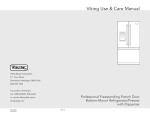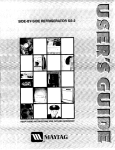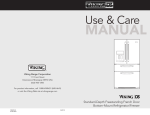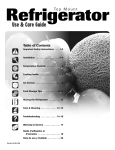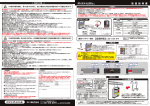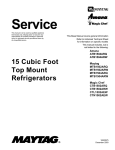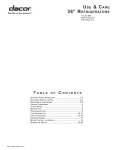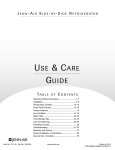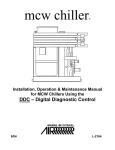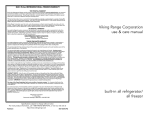Download Viking DDSB548SS Operating instructions
Transcript
Viking Use & Care Manual Viking Range Corporation 111 Front Street Greenwood, Mississippi 38930 USA (662) 455-1200 For product information call 1-888-VIKING1 (845-4641) or visit the Viking Web site at vikingrange.com Freestanding Bottom-Mount/French Door Bottom-Mount Refrigerator/Freezers F20394A 12929167 (091207J) Important Safety Instructions Congratulations . . . Your purchase of this product attests to the importance you place upon the quality and performance of the major appliances you use. With minimal care, as outlined in this guide, this product is designed to provide you with years of dependable service. Please take the few minutes necessary to learn the proper and efficient use and care of this quality product. We appreciate your choosing a Viking Range Corporation product, and hope that you will again select our products for your other major appliance needs. Table of Contents Important Safety Instructions . . . . . . . . . . . . . . . . . . . . . . . . . . . . 3 Proper Disposal of Your Old Refrigerator . . . . . . . . . . . . . . . . . . . 4 Temperature Controls . . . . . . . . . . . . . . . . . . . . . . . . . . . . . . . . . . 5 Refrigerator Features . . . . . . . . . . . . . . . . . . . . . . . . . . . . . . . . . . 8 Freezer Features . . . . . . . . . . . . . . . . . . . . . . . . . . . . . . . . . . . . . . 12 Water Filter . . . . . . . . . . . . . . . . . . . . . . . . . . . . . . . . . . . . . . . . . . 15 Food Storage Tips . . . . . . . . . . . . . . . . . . . . . . . . . . . . . . . . . . . . 20 Care and Cleaning . . . . . . . . . . . . . . . . . . . . . . . . . . . . . . . . . . . . 24 Operating Sounds. . . . . . . . . . . . . . . . . . . . . . . . . . . . . . . . . . . . . 29 Troubleshooting . . . . . . . . . . . . . . . . . . . . . . . . . . . . . . . . . . . . . . 30 Service Information . . . . . . . . . . . . . . . . . . . . . . . . . . . . . . . . . . . . 34 Warranty . . . . . . . . . . . . . . . . . . . . . . . . . . . . . . . . . . . . . . . . . . . . 35 Your safety is important to us. This use and care manual contains safety symbols and statements. Please pay special attention to these symbols and follow any instructions given. This symbol alerts you to hazards such as fire, electrical shock or other injuries. WARNING To reduce the risk of fire, electric shock, or injury when using your refrigerator, follow these basic precautions: •Read all instructions before using the refrigerator. •Observe all local codes and ordinances. Install refrigerator according to Installation Instructions. All connections for water, electrical power and grounding must comply with local codes and be made by licensed personnel when required. •Do not modify plug on power cord. If plug does not fit electrical outlet, have proper outlet installed by a qualified technician. Replace worn power cords and/or loose plugs. •Do not ground to a gas line or cold-water pipe. •Do not remove warning tag from power cord. •Refrigerator is designed to operate on a separate 115 volt, 15 amp., 60 cycle line. •Do not tamper with refrigerator controls. •Do not service or replace any part of refrigerator unless specifically recommended in Use & Care or Installation Instructions. Do not attempt service if instructions are not understood or if they are beyond personal skill level. •Always disconnect refrigerator from electrical supply before attempting to change light bulbs, clean, or service the refrigerator. Disconnect the power cord by grasping the plug, not the cord. •Always read and follow manufacturer’s storage and ideal environment instructions for items being stored in refrigerator. •Never allow children to operate, play with, crawl inside or stand on any part the refrigerator. •Never clean refrigerator parts with flammable fluids. The fumes can create a fire hazard or explosion. •Clean up spills or water leakage associated with water installation. •Keep your refrigerator in good condition. Bumping or dropping refrigerator can damage refrigerator or cause refrigerator to malfunction or leak. If damage occurs, have refrigerator checked by qualified service technician. -SAVE THESE INSTRUCTIONS- 2 3 Proper Disposal of Your Old Refrigerator •FOR YOUR SAFETY• DO NOT STORE OR USE GASOLINE OR OTHER FLAMMABLE VAPORS AND LIQUIDS IN THE VICINITY OF THIS OR ANY OTHER APPLIANCE. THE FUMES CAN CREATE A FIRE HAZARD OR EXPLOSION. Temperature Controls ELECTRONIC TEMPERATURE CONTROL ORDER UP MAX ICE DOWN REPLACE REFRIGERATOR FREEZER TEMP WATER FILTER INDICATOR HOLD 3 SECONDS TO RESET VACATION MODE HIGH TEMP ALARM DOOR OPEN ALARM MAX COLD VIKING TEMP UP DOWN Initial Temperature Setting WARNING ELECTRICAL SHOCK HAZARD Plug into a grounded 3-prong outlet. If a 2-prong wall receptacle is encountered, contact a qualified electrician. Do not remove ground prong. Unit must be grounded at all times. Do not use an adapter. Do not use an extension cord. Failure to follow these instructions can result in death, fire, or electrical shock. DANGER Risk of Child Entrapment BEFORE YOU THROW AWAY YOUR OLD REFRIGERATOR OR FREEZER: •Take off the doors. •Leave the shelves in place so that children may not easily climb inside. Temperatures are preset at the factory at 38° F (3° C) in the refrigerator compartment and 0° F (-18° C) in the freezer compartment. Adjusting the Control 24 hours after adding food, you may decide that one or both compartments should be colder or warmer. If so, adjust the control as indicated in the Temperature Control Guide below. • The first touch of the UP or DOWN pads shows the current temperature setting. • The display will show the new setting for approximately three seconds, and then return to the actual temperature currently within that compartment. • Do not change either control more than one degree at a time. Allow temperature to stabilize for 24 hours before making a new temperature adjustment. Temperature Control Guide Refrigerator too cold IMPORTANT: Child entrapment and suffocation are not problems of the past. Junked or abandoned refrigerators are still dangerous... even if they will sit for “just a few days.” Set the refrigerator control to next higher number by pressing the UP pad. Set the refrigerator control to next lower number by pressing the DOWN pad Set the freezer control to next higher number by pressing the UP pad. Set the freezer control to next lower number by pressing the DOWN pad. Press the freezer UP pad until OFF appears in the display. Press either the freezer or refrigerator DOWN pad to turn back on. Refrigerator too warm Freezer too cold Freezer too warm Turn refrigerator OFF 4 5 Temperature Controls Temperature Controls Max Ice When activated, Max Ice reduces the freezer temperature to the optimum setting for 24 hours in order to produce more ice. Note: When the Max Ice feature is in operation, the UP and DOWN pads for the freezer control will not operate. Door Open Alarm The Door Open Alarm will alert you when one of the doors has been left open for five continuous minutes. When this happens, an audible alarm will sound every few seconds until the door is closed OR press the Door Open Alarm pad to deactivate the feature. Water Filter Indicator When a water filter has been installed in the refrigerator, the yellow Order light will illuminate when 90 percent of the volume of water for which the filter is rated has passed through the filter OR 11 months have elapsed since the filter has been installed. Max Cold When activated, Max Cold causes the refrigerator and freezer temperatures to drop to the minimum settings on the control. This cools down the refrigerator and freezer after extended door openings or when loading the refrigerator or freezer with warm food. Note: When the Max Cold feature is in operation, the UP and DOWN pads for the refrigerator and freezer controls will not operate. The red Replace light will illuminate when the rated volume of water has passed through the filter OR 12 months have elapsed since the filter was installed. A new filter should be installed immediately when the Replace light is illuminated. After replacing the filter, press and hold the Water Filter Indicator button for three seconds. The Order and Replace lights will go off. Vacation Mode The Vacation Mode feature causes the freezer to defrost less frequently, conserving energy. The Vacation Mode indicator light will illuminate when the feature is activated. To deactivate, press the Vacation Mode pad again OR open either door. The indicator light will go out. NOTE: Door openings will not deactivate the Vacation Mode for approximately one hour after activation. If vacationing for more than a few days, see the Preparing for Vacation section, page 27. High Temp Alarm The High Temp Alarm system will alert you if the freezer or refrigerator temperatures exceed normal operating temperatures due to a power outage or other event. When activated, the High Temp Alarm light will illuminate. If the freezer or refrigerator temperatures have exceeded these limits, the display will alternately show the current compartment temperatures and the highest compartment temperatures reached when the power was out. An audible alarm will sound repeatedly. Press the High Temp Alarm pad once to stop the audible alarm. The High Temp Alarm light will continue to flash and the temperatures will alternate until the temperatures have stabilized. To turn off High Temp Alarm, press and hold the High Temp Alarm pad for three seconds. The indicator light will go off. 6 To activate, press the Max Cold pad. Max Cold will deactivate automatically after 12 hours, OR press the Max Cold pad to deactivate the feature. User Preferences Access the User Preferences menu to: • Change the temperature display from °F to °C • Enable or disable audible alarms • Activate the Sabbath Mode To access the User Preferences menu, press and hold the Door Open Alarm pad for three seconds. When in the User Preferences mode, a short title for the feature will appear in the Freezer temperature display and the feature status will appear in the Refrigerator display. 1. Use the freezer UP and DOWN control to scroll through the features. 2. When the desired feature is displayed, use the refrigerator UP and DOWN control to change the status. 3. When changes are complete, press the Door Open Alarm pad for three seconds OR close the refrigerator door. Temperature Display (F_C) Change the display to show temperatures in degrees Fahrenheit or degrees Celsius. Alarm (AL) When the Alarm mode is OFF, all audible alarms will be disabled until the feature is turned on. 7 Sabbath Mode (SAB) When the Sabbath Mode is ON, all control lights will be disabled until the feature is turned OFF. This feature does not disable the interior lights. Press any pad to restore the control lights. Warm Cabinet Surfaces At times, the front of the refrigerator cabinet may be warm to the touch. This is a normal occurrence that helps prevent moisture from condensing on the cabinet. This condition will be more noticeable when the refrigerator is first started, during hot weather and after excessive or lengthy door openings. Refrigerator Features Refrigerator Features Door Storage Dairy Compartment The Dairy Compartment provides convenient door storage for spreadable items such as butter and margarine. This compartment can be moved to different locations to accommodate storage needs. To use the dairy compartment, raise the cover. To Remove: • Raise the cover, pull upward and tilt out. To Install: • Reverse above procedure. CAUTION To avoid personal injury or property damage, observe the following: • Never attempt to adjust a shelf that is loaded with foods. • Confirm shelf is secure before placing items on shelf. • Handle tempered glass shelves carefully. Shelves may break suddenly if nicked, scratched, or exposed to sudden temperature change. Shelves To Remove a Shelf: • Slightly tilt up the front and lift up the rear of the shelf, then pull the shelf straight out. To Lock the Shelf Into Another Position: • Tilt up the front edge of the shelf. • Insert the hooks into the desired frame openings and let the shelf settle into place. • Be sure the shelf is securely locked at the rear. The Produce Drawer Top serves as the lower fresh food shelf. To Remove the Produce Drawer Top: • Remove produce drawers as indicated on page 9. • Place hand under the frame to push up the glass. Lift glass out. • Lift frame from refrigerator liner rails. • To install, repeat above instructions in reverse order. Door Bins Door Bins can be moved to meet storage needs. To Remove: • Slide bin up and pull straight out. To Install: • Slide bin in and down until firmly seated in the door liner. Moisture Adjustable Produce Drawers The Produce Drawers provide a higher humidity environment for fresh fruit and vegetable storage. Controls The Produce controls regulate the amount of moisture in the drawer. Slide the control towards the LOW setting when storing produce with outer skins. Slide the control towards the HIGH setting when storing leafy produce. To Remove: • Pull drawer out to full extension. Tilt up front of drawer and pull straight out. To Install: • Insert drawer into frame rails and push back into place. NOTE: For best results, keep the Produce drawers tightly closed. 8 9 Refrigerator Features Refrigerator Features MeatSavor™/Produce Drawer Water Dispenser The MeatSavor drawer is a full-width drawer with adjustable temperature control. This drawer can be used for large party trays, deli items, beverages or miscellaneous items. There is a divider to organize the drawer into sections if desired. The Water Dispenser is located on the left side wall of the refrigerator section. This is designed for cold water dispensing only. MeatSavor Control The control, located on the right of the drawer, regulates the air temperature inside the drawer. Set control to “cold” to provide normal refrigerator temperature. Use the “coldest” setting for meats or other deli items. NOTE: • Cold air directed to the MeatSavor can decrease refrigerator temperature. Refrigerator control may need to be adjusted. • Do not place leafy vegetables in the MeatSavor drawer. Colder temperatures could damage leafy produce. To Remove: • Lift lid. Pull drawer out to full extension. Tilt the drawer front up and pull straight out. To Install: • Push metal glide rails to the back of the refrigerator. Place drawer onto rails and slide drawer back until it falls into place. To Remove Divider: • Pull drawer completely out and raise the front of the divider to unhook it from rear wall of the drawer and lift it out. To Dispense Water: • Hold container under spout and press dispenser pad. Accessories Egg Bin The egg bin has three pieces - the lid, the egg tray, and the bin. Use the egg bin to hold one, or two dozen eggs. To hold one dozen eggs: Place a dozen eggs into the egg carrier. Then place the egg carrier into the bin and cover with the lid. Lid Egg Tray Bin To hold two dozen eggs: Place two dozen eggs loose in the bin and cover them with the lid. Use the carrier to transport eggs between the bin and your cooking area. When the egg tray is removed, the bin will accept items such as a standard egg carton, ice, etc. Glass Butter Tray To Install Divider: • Hook back of divider over rear wall of drawer and lower into place. 10 The glass butter tray holds two sticks of butter for storage in the dairy compartment. 11 Freezer Features Freezer Features Upper Wire Basket Accessories Ice Bin DANGER To prevent accidental child entrapment or suffocation risk, do not remove the divider in the top freezer basket To Remove: • Pull upper basket out to full extension and lift out to remove. The Ice Bin provides storage for ice. To Remove the Ice Bin: • Pull it forward, away from the ice maker. To avoid the ice maker dumping ice while the bin is removed, turn the ice maker off by raising the icemaker arm. To Install the Ice Bin: • Reverse the above procedure. Turn the ice maker on by lowering the ice maker arm. Lower Basket Divider To Install: • Slide upper basket into freezer. Make sure that rear of basket hooks behind rail catch. The Lower Basket Divider allows the option to organize the basket area into sections. To remove and replace divider: • To remove, pull divider straight up. • To install, hook top corners of divider over top horizontal basket rungs. WARNING Lower Freezer Basket To Remove: • Pull drawer open to full extension. • Tilt the lower basket forward and lift to remove. To Install: • Tilt the lower basket front down and set it down into the basket cradles. 12 To avoid personal injury or property damage, observe the following: • Do not place fingers or hands on the automatic ice making mechanism while the refrigerator is plugged in. This will help protect you from possible injury. It will also prevent interference with moving parts of the ejector mechanism and the heating element that releases the cubes. • Under certain rare circumstances, ice cubes may be discolored, usually appearing with a green-bluish hue. The cause of this unusual discoloration can be a combination of factors such as certain characteristics of local waters, household plumbing and the accumulation of copper salts in an inactive water supply line which feeds the ice maker. Continued consumption of such discolored ice cubes may be injurious to health. If such discoloration is observed, discard the ice cubes and contact your dealer to purchase and install a water line filter. • Water damage due to improper water connection may cause mold/mildew growth. • Clean up water and ice spills to avoid personal injury and to prevent mold/mildew growth. 13 Freezer Features Water Filter Automatic Ice Maker Removal and Installation Connect the ice maker to the water supply as instructed. Proper water flow and a level refrigerator are essential for optimal ice maker performance. Operating Instructions • Confirm ice bin is in place and ice maker arm is down. • After freezer section reaches between 0° to 2° F (-18° to -17° C), ice maker fills with water and begins operating. You will have a complete harvest of ice approximately every three hours. • Allow approximately 24 hours after installation to receive first harvest of ice. • Discard ice created within first 12 hours of ice maker operation to assure system is flushed of impurities. • Stop ice production by raising ice maker arm until click is heard. • Ice maker will remain in the off position until arm is pushed down. • The first one or two batches will probably contain undersized and irregular cubes because of air in the supply line. • When the ice cubes are ejected it is normal for several cubes to be joined together at the ends. They can easily be broken apart. The ice maker will continue to make ice until the supply of ice cubes raises the ice maker arm, shutting the ice maker off. • Certain sounds may accompany the various cycles of the ice maker. The motor may have a slight hum, the cubes will rattle as they fall into an empty storage pan and the water valve may click or “buzz” occasionally. • If the ice is not used frequently, the ice cubes will become cloudy, shrink, stick together and taste stale. Empty the ice storage bin periodically and wash it in lukewarm water. Be sure to dry the bin thoroughly before replacing it. • Beverages and foods should not be placed in the ice storage bin for quick chilling. These items can block the ice maker arm, causing the ice maker to malfunction. • Turn off (arm up) the ice maker when the water supply is to be shut off for an extended period of time. 14 WARNING To avoid serious illness or death, do not use refrigerator where water is unsafe or of unknown quality without adequate disinfection before or after use of filter. CAUTION After installing a new water filter, always dispense water for two minutes before removing the filter for any reason. Air trapped in system may cause water and cartridge to eject. Use caution when removing. • The bypass cap does not filter water. Be sure to have replacement cartridge available when filter change is required. • If water filtration system has been allowed to freeze, replace filter cartridge. • If system has not been used for several months, or water has an unpleasant taste or odor, flush system by dispensing two to three glasses of water. If unpleasant taste or odor persists, change filter cartridge. If system has not been use for three months or more, replace water filter cartridge. Initial Installation The water filter is located in the upper right hand corner of the fresh food compartment. • Remove sealing label from end of filter and insert into filter head. • Rotate gently clockwise until filter stops. Snap filter cover closed. • Reduce water spurts by flushing air from system. Run water continuously for two minutes through dispenser until water runs steady. During initial use, allow about a one- to two-minute delay in water dispensing to allow internal water tank to fill. • Additional flushing may be required in some households where water is of poor quality. 15 Water Filter Water Filter Replacing Water Filter Standard No. 42: Aesthetic Effects Important: Air trapped in system may cause water and cartridge to eject. Always dispense water for two minutes before removing the filter for any reason. Use caution when removing. • Turn filter counterclockwise until it releases from filter head. • Drain water from filter into sink, and dispose of filter in normal household trash. • Wipe up excess water in filter cover and continue with Initial Installation. The filter should be changed at least every 12 months. Important: Condition of water and amount used determines life span of water filter cartridge. If water use is high, or if water is of poor quality, replacement may need to take place more often. Replacement water filters are available through your local Viking Range Dealer. You may also order filters by calling 1-888-845-4641 or online at vikingrange.com The dispenser feature may be used without a water filter cartridge. If you choose this option, replace filter with blue bypass cap. System Specification and Performance Data Sheet Refrigerator Water Filter Cartridge Model RWFFR Specifications Service Flow Rate (Maximum) ............................... 0.78 GPM ...............................................................................(2.9 L/min) Rated Service Life RWFFR (750 gal. Max) .............750 gal. /2838 liters Maximum Operating Temperature .......................100° F / 38° C Minimum Pressure Requirement ...........................35 psi /241 kPA Minimum Operating Temperature.........................33° F/1° C Maximum Operating Pressure...............................120 psi / 827 kPA 1000 Apollo Road Egan, Minnesota 55121-2240 Influent Challenge Concentration Min. Influent Effluent %Reduction Required Average Average Maximum Average Minimum Reduction Parameter USEPA MCL Chlorine __ T&O __ __ __ __ Particulate** __ at least 10,000 particles/ml 5,700,000 #/ml 30,583 #/ml 2.0 mg/L + 10% 1.88 mg/L <0.051363 0.06 mg/L mg/L 96.84% 50% __ __ __ __ 69,000 #/ml 99.52% 98.94% 85% Standard No. 53: Health Effects Parameter USEPA MCL Min. Influent Influent Effluent %Reduction Required Challenge Average Average Maximum Average Minimum Reduction Concentration Turbidity 1NTU** 11 + 1 NTU*** 10.7 NTU .031 NTU 99.5% Reduction Minimum 166,500 Cysts <1 #/L 50,000/L #/L 7 8 10 10 fibers/L; 99% fibers >10 Asbestos 155 MF/L <1 MF/L Reduction micrometers in length 0.015 0.15 mg/L + 0.153 <0.001 Lead at pH 6.5 10% mg/L mg/L mg/L 0.015 0.15 mg/L + 0.150 <0.001 Lead at pH 8.5 mg/L mg/L mg/L 10% Mercury at pH 0.002 .006 mg/L + 0.006 0.0003 mg/L mg/L mg/L 6.5 10% Mercury at pH 0.002 .006 mg/L + 0.006 0.0008 mg/L mg/L mg/L 8.5 10% 0.003 0.009 mg/L + 0.009 <0.002 Atrazine mg/L mg/L mg/L 10% 0.005 0.015 mg/L + 0.014 0.0006 Benzene mg/L mg/L mg/L 10% 0.04 0.08 mg/L + 0.081 <0.001 Carbofuran mg/L mg/L mg/L 10% 0.49 NTU 97.09% 95.20% 0.5NTU <1 #/L >99.99% >99.99% >99.95% <1 MF/L >99.99% >99.99% 99% >99.35% >99.29% 0.10 mg/L >99.33% >99.29% 0.10 mg/L <0.001 mg/L <0.001 mg/L 0.0005 mg/L 0.0015 mg/L 0.002 mg/L 0.0011 mg/L <0.001 mg/L 95.70% 90.91% 0.002 mg/L 86.22% 75.93% 0.002 mg/L 76.99% 75.31% 0.003 mg/L 95.71% 92.14% 0.005 mg/L 98.74% 98.46% pDichlorobenzene 0.075 mg/L 0.225 mg/L + 10% 0.208 mg/L <0.0005 mg/L <0.0005 mg/L 99.76% 99.74% 0.075 mg/L Lindane 0.0002 mg/L 0.002 mg/L + 10% 0.002 mg/L 0.000 mg/L <0.0001 mg/L 98.72% 96.50% Toxaphene 0.003 mg/L 0.015 mg/L + 10% 0.015 mg/L <0.001 mg/L <0.001 mg/L 92.97% 91.67% 0.003 mg/L 0.04 mg/L 0.0002 mg/L *Tested using a flow rate of 0.78 gpm; pressure of 60psig; pH of 7.5 + 0.5; temp of 68o + 5oF (20o + 3oC). **Measurement in Particles/ml. Particles used were 0.5 - 1 microns ***NTU - Nephelometric Turbidity Units (651) 450-4913 EPA EST #35917-MN-1 100834/B 16 >97.26% 17 Water Filter Water Filter Tested and certified by NSF International against ANSI/NSF Standards 42 & 53 in models RWFFR for the reduction of: Standard No. 42 Standard No. 53 Aesthetic Effects: Health Effects: Taste and Odor Reduction Chemical Reduction Unit Chlorine Taste & Odor Lead, Atrazine, Lindane, Mechanical Filtration Unit Benzene, Carbofuran, Particulate Reduction Class I p-Dichlorobenzene, Mercury, & Toxaphene Reduction Mechanical Filtration Unit Cyst, Turbidity & Asbestos Reduction State of California Department of Health Services Water Treatment Device Certificate Number 06 - 1790 Date Issued: June 1, 2006 Trademark /Model Designation RWFFR-750 Replacement Elements RWFFR General Use Conditions Read this Performance Data Sheet and compare the capabilities of this unit with your actual water treatment needs. DO NOT use this product where water is microbiologically unsafe or of unknown quality without adequate disinfection before or after the system. System certified for cyst reduction may be used on disinfected water that may contain filterable cysts. USE ONLY WITH COLD WATER SUPPLY. CHECK FOR COMPLIANCE WITH THE STATE AND LOCAL LAWS AND REGULATIONS. The retractable water filtration system uses a RWFFR replacement cartridge. Timely replacement of filter cartridge is essential for performance satisfaction from this filtration system. Please refer to the applicable section of your Use & Care Guide for general operation, maintenance requirements and troubleshooting. This system has been tested according to ANSI/NSF 42 and 53 for reduction of the substance listed above. The concentration of the indicated substances in water entering the system was reduced to a concentration less than or equal to the permissible limit for water leaving the system, as specified in ANSI/NSF 42 and 53. Manufacturer: CUNO, Incorporated, a 3M Company The water treatment device(s) listed on this certificate have met the testing requirements pursuant to Section 116830 of the Health and Safety Code for the following health related contaminants: Microbiological Contaminants and Turbidity Inorganic/Radiological Contaminants Cysts Turbidity Asbestos Lead Mercury Organic Contaminants Atrazine Lindane Benzene Carbofuran p-dichlorobenzene Toxaphene Rated Service Capacity: 750 gallons Rated Service Flow: 0.78 gpm Conditions of Certification: Do not use where water is microbiologically unsafe or with water of unknown quality, except that systems certified for cyst reduction may be used on disinfected waters that may contain filterable cysts. 18 19 Food Storage Tips Food Storage Tips Frozen Food Storage Fresh Food Storage • The refrigerator should be kept between 34°-40° F (3.1°-4° C) with an optimum temperature of 38° F (3.3° C). To check the temperature, place an appliance thermometer in a glass of water and place in the center of the refrigerator. Check after 24 hours. If the temperature is above 40° F (4° C) adjust the control as explained on page 5. • Avoid overcrowding the refrigerator shelves. This reduces the circulation of air around the food and results in uneven cooling. • The freezer compartment of a refrigerator should be kept at approximately 0° F (-18° C). To check the temperature, place an appliance thermometer between the frozen packages and check after 24 hours. If the temperature is above 0° F (-18° C), adjust the control as described on page 5. • A freezer operates more efficiently when it is at least two-thirds full. Fruits and Vegetables • To minimize dehydration and quality deterioration use aluminum foil, freezer wrap, freezer bags or airtight containers. Force as much air out of the packages as possible and be sure they are tightly sealed. Trapped air can cause the food to dry out, change color and develop an off-flavor (freezer burn). • Wrap fresh meats and poultry with suitable freezer wrap prior to freezing. • Do not refreeze meat that has completely thawed. • Storage in the produce drawers traps humidity to help preserve the fruit and vegetable quality for longer time periods (see page 9). • Sort fruits and vegetables before storage and use bruised or soft items first. Discard those showing signs of decay. • Always wrap odorous foods such as onions and cabbage so the odor does not transfer to other foods. • While vegetables need a certain amount of humidity to remain fresh, too much humidity can shorten storage times (especially leafy vegetables). Drain vegetables well before storing. • Wait to wash fresh produce until right before use. Meat and Cheese • Raw meat and poultry should be wrapped securely so leakage and contamination of other foods or surfaces does not occur. • Occasionally mold will develop on the surface of hard cheeses (Swiss, Cheddar, Parmesan). Cut off at least an inch around and below the moldy area. Keep your knife or instrument out of the mold itself. Do not try to save individual cheese slices, soft cheese, cottage cheese, cream, sour cream or yogurt when mold appears. Dairy Food Packaging Foods for Freezing Loading the Freezer • Avoid adding too much warm food to the freezer at one time. This overloads the freezer, slows the rate of freezing and can raise the temperature of frozen foods. • Leave space between the packages so cold air can circulate freely, allowing food to freeze as quickly as possible. • Avoid storing hard-to-freeze foods such as ice cream and orange juice on the freezer door shelves. These foods are best stored in the freezer interior where the temperature varies less with door openings. Refer to the Food Storage Chart on pages 22 and 23 for approximate storage times. • Most dairy foods such as milk, yogurt, sour cream and cottage cheese have freshness dates on their cartons for appropriate length of storage. Store these foods in the original carton and refrigerate immediately after purchasing and after each use. 20 21 Food Storage Tips Food Storage Tips Food Storage Chart Storage times are approximate and may vary depending on type of packaging, storage temperature, and the quality of the food when purchased. Foods DAIRY PRODUCTS Butter Milk and cream Refrigerator 1 month 1 week Freezer 6 to 9 months Not recommended Cream cheese, cheese spread and cheese food Cottage cheese 1 to 2 weeks 3 to 5 days Not recommended Sour cream 10 days Not recommended Hard cheese 1 to 2 months (Swiss, Cheddar and Parmesan) EGGS Eggs in the shell Leftover yolks or whites FRUITS Apples 3 weeks 2 to 4 days 1 month Not recommended 4 to 6 months May become crumbly Not recommended 9 to 12 months 8 months (cooked) Bananas 2 to 4 days 6 months (whole/peeled) Pears, plums, avocados 3 to 4 days Not recommended Berries, cherries, apricots Grapes 2 to 3 days 6 months 3 to 5 days 1 month (whole) Citrus fruits 1 to 2 weeks Not recommended Pineapples, cut 2 to 3 days 6 to 12 months 22 Storage Tips Wrap tightly or cover. Check carton date. Close tightly. Don’t return unused portions to original container. Don’t freeze cream unless whipped. Wrap tightly. Store in original carton. Check carton date. Store in original carton. Check carton date. Wrap tightly. Cut off any mold. Refrigerate small ends down. For each cup of yolks to be frozen, add 1 tsp. sugar for use in sweet, or 1 tsp. salt for nonsweet dishes. May also store unripe or hard apples at 60° to 70° F (16° to 21° C). Ripen at room temperature before refrigerating. Bananas darken when refrigerated. Ripen at room temperature before refrigerating. Avocados darken when refrigerated. Ripen at room temperature before refrigerating. Ripen at room temperature before refrigerating. May also store at 60° to 70° F (16° to 21° C). If refrigerated, store uncovered. Will not ripen after purchase. Use quickly. Foods VEGETABLES Asparagus Refrigerator 1 to 2 days Brussels sprouts, 3 to 5 days broccoli, cauliflower, green peas, lima beans, onions, peppers Cabbage, celery 1 to 2 weeks Carrots, parsnips, beets and turnips 7 to 10 days Lettuce 7 to 10 days POULTRY and FISH Chicken and Turkey, 1 to 2 days whole Chicken and Turkey, 1 to 2 days pieces Fish 1 to 2 days Freezer 8 to 10 months 8 to 10 months Storage Tips Do not wash before refrigerating. Store in crisper. Wrap odorous foods. Leave peas in pods. Not recommended Wrap odorous foods and refrigerate in crisper. Remove tops. Wrap odorous 8 to 10 months foods and refrigerate in the crisper. Not recommended 12 months 9 months 2 to 6 months Keep in original packaging for refrigeration. Place in the meat and cheese drawer. When freezing longer than two weeks, Wrap with freezer wrap. MEATS Bacon Beef or lamb, ground 7 days 1 to 2 days 1 month 3 to 4 months Fresh meats can be kept in original packaging for refrigeration. Beef or lamb, roast and steak 3 to 5 days 6 to 9 months Ham, (fully cooked) whole half slices Luncheon meat Place in the meat and cheese drawer. When freezing longer than two weeks, Wrap with freezer wrap. 7 5 3 3 days days days to 5 days 1 1 1 1 to to to to Pork, roast Pork, chops Sausage, ground Sausage, smoked Veal Frankfurters 3 3 1 7 3 7 to 5 days to 5 days to 2 days days to 5 days days 4 4 1 1 4 1 to 6 months months to 2 months to 2 months to 6 months month 2 2 2 2 months months months months Unopened, vacuum-packed luncheon meat may be kept up to two weeks in the meat and cheese drawer. Processed meats should be tightly wrapped and stored in the meat and cheese drawer. Sources: United States of Agriculture; Food Marketing Institute; Cooperative Extension Service, Iowa State University 23 Care and Cleaning Care and Cleaning CAUTION WARNING To avoid electrical shock which can cause severe personal injury or death, disconnect power to refrigerator before cleaning. After cleaning, connect power. To avoid personal injury or property damage, observe the following: • Read and follow manufacturer’s directions for all cleaning products. • Do not place bins, shelves, or accessories in dishwasher. Cracking or warping of accessories may result. Refrigerator Cleaning Chart PART Cabinet Interior Stainless Steel Parts *NOTE: Damage to stainless steel finish due to improper use of cleaning products is not covered under the product warranty Door Gaskets DO NOT USE Abrasive or harsh cleaners Ammonia Chlorine Bleach Concentrated detergents Metal or plastic-textured scouring pads Abrasive or harsh cleaners Ammonia Chlorine Bleach Concentrated detergents Metal or plastic-textured scouring pads Vinegar-based cleaners Citrus-based cleaners Metal or plastic-textured scouring pads Condenser Coil Anything other than a Remove base grille to access vacuum cleaner Condenser Fan Outlet See back of refrigerator Accessories A dishwasher shelves, bins, drawers, etc. 24 DO Use 4 tablespoons of baking soda dissolved in 1 quart (1 liter) warm soapy water. Rinse surfaces with clean warm water and dry immediately to avoid water spots. Use warm soapy water and a soft, clean cloth or sponge. Rinse with clean warm water and dry immediately to avoid water spots Use warm, soapy water and a soft, clean cloth or sponge. Apply a light film of petroleum jelly to keep pliable. Use a vacuum cleaner hose nozzle Use vacuum cleaner hose nozzle with brush attachment Follow removal and installation instructions from appropriate section. Allow items to adjust to room temperature. Dilute mild detergent and use a soft clean cloth or sponge for cleaning. Use a plastic bristle brush to get into crevices. Rinse with clean warm water. Dry glass and clear items immediately to avoid spots Removing Odors From Refrigerator • Remove all food and turn the refrigerator OFF. • Disconnect power to the refrigerator. • Clean the walls, floor, ceiling of cabinet interior, drawers, shelves and gaskets according to the instructions (see page 24). • Dilute mild detergent and brush solution into crevices using a plastic bristle brush. Let stand for five minutes. Rinse surfaces with warm water. Dry surfaces with a soft, clean cloth. • Wash and dry all bottles, containers and jars. Discard spoiled or expired items. • Wrap or store odor-causing foods in tightly sealed containers to prevent recurring odors. • Reconnect power to refrigerator and return food to refrigerator. • Allow the refrigerator to cool. • After 24 hours, check if odor has been eliminated. If odor is still present: • Remove drawers and place on top shelf of refrigerator. • Pack refrigerator and freezer sections – including doors – with crumpled sheets of black and white newspaper. • Place charcoal briquettes randomly on crumpled newspaper in both freezer and refrigerator compartments. • Close doors and let stand 24 to 48 hours. Energy Saving Tips • Avoid overcrowding refrigerator shelves. This reduces air circulation around food and causes refrigerator to run longer. • Avoid adding too much warm food to refrigerator at one time. This overloads compartments and slows rate of cooling. • Do not use aluminum foil, wax paper, or paper toweling as shelf liners. This decreases air flow and causes refrigerator to run less efficiently. • A freezer that is two-thirds full runs most efficiently. • Locate refrigerator in coolest part of room. Avoid areas of direct sunlight, or near heating ducts, registers or other heat producing appliances. If this is not possible, isolate exterior by using a section of cabinet or an added layer of insulation. • Clean door gaskets every three months according to cleaning instructions. This will assure that door seals properly and refrigerator runs efficiently. • Take time to organize items in refrigerator to reduce time that door is open. 25 Care and Cleaning Care and Cleaning Energy Saving Tips (con’t) Preparing for Vacation • Be sure your doors are closing securely by leveling refrigerator as instructed in your installation instructions. • Clean condenser coils as indicated in the cleaning instructions every three months. This will increase energy efficiency and cooling performance. Replacing Light Bulbs CAUTION WARNING To avoid electrical shock which can cause severe personal injury or death, disconnect power to refrigerator before replacing light bulb. After replacing light bulb, connect power. To avoid personal injury or property damage, observe the following: • Allow light bulb to cool • Wear gloves when replacing light bulb Refrigerator Compartment • Slide clear light shield toward back of compartment to release from light assembly. • Remove light bulbs. • Replace with appliance bulbs no greater than 40 watts. • Replace light bulb cover by inserting tabs on light shield into liner holes on each side of light assembly. Slide shield toward front of refrigerator until it locks into place. Do not force shield beyond locking point. Doing so may damage light shield. Freezer Compartment • Reach behind the light cover. • With firm pressure, press forward on the notches at the back of the cover and pull down. The cover will open from the back. • Remove the cover. • Remove light bulb. • Replace bulb with appliance bulb no greater than 40 watts. • Insert front tabs of light cover into slots in freezer liner and snap rear portion over light assembly until rear tab engages. 26 CAUTION If your refrigerator has a dispenser and there is any possibility that the temperature can drop below freezing where the refrigerator is located, the water supply system (including the water tank and the water valve) must be drained by a qualified servicer. For short vacations or absences (three months or less): • Remove all perishables. • If no one will be checking in on the refrigerator during your absence, remove all frozen items also. • If your refrigerator has an automatic ice maker: • Shut off the water supply to the ice maker at least one day ahead of time. • After the last load of ice drops, raise the wire shut off arm to the OFF position. • Empty the ice bin. • If the room temperature will drop below 55° F (13° C), follow the instructions for longer absences. For long vacations, absences (more than three months) OR if the room temperature will drop below 55° F (13° C): • Remove food. • If your refrigerator has an automatic ice maker: • Shut off the water supply to the ice maker at least one day ahead of time. • After the last load of ice drops, raise the wire shut off arm to the OFF position. • Empty the ice bin. • If your refrigerator has a dispenser system with water filter, remove the water filter cartridge and install the filter bypass. Dispose of the used cartridge. • Turn the freezer control to (OFF). • Unplug the refrigerator. • Thoroughly clean the interior of both compartments with a baking soda solution and a clean soft cloth (four tablespoons of baking soda in one quart of warm water.). • Dry thoroughly. • Leave the doors open to prevent the formation of mold and mildew. 27 Care and Cleaning Operating Sounds Upon Your Return Improvements in refrigeration design may produce sounds in your new refrigerator that are different or were not present in an older model. These improvements were made to create a refrigerator that is better at preserving food, is more energy efficient, and is quieter overall. Because new refrigerators run quieter, sounds may be detected that were present in older refrigerators, but were masked by higher sound levels. Many of these sounds are normal. Please note that the surfaces adjacent to a refrigerator, such as hard walls, floors and cabinetry may make these sounds seem even louder. The following are some of the normal sounds that may be noticed in a new refrigerator. After a Short Vacation or Absence: For models with automatic ice makers or dispensers: • Reconnect the water supply and turn on supply valve (see Installation Instructions). • Monitor water connection for 24 hours and correct leaks if necessary. • Run 10-15 glasses of water from the dispenser to flush out the system. • Restart the ice maker by lowering the ice maker arm. • Discard at least the first three ice harvests. After a Long Vacation or Absence: • If your refrigerator has an automatic ice maker, reconnect the water supply and turn on supply valve (see Installation Instructions). • Plug the refrigerator back in and reset controls (see page 5). • Monitor water connection for 24 hours and correct leaks, if necessary. For dispenser models, run water through the dispenser for at least three minutes with the filter bypass in place, then install water filter (see page 15). • After installing the water filter, run water through the dispenser continuously for at least two minutes, or until water runs steady. Initially you may notice a one to two minute delay in water dispersal as the internal tanks fills. • Restart the ice maker by lowering the ice maker arm. • Discard ice produced within the first 12 hours (at least the first three harvests). Preparing to Move SOUND Buzzing • Follow the above instructions for long vacations/absences. • Secure all loose items such as shelves and drawers by taping them securely in place to prevent damage. • Tape the doors shut. • Use an appliance dolly when moving the refrigerator. Always truck the refrigerator from its side or back never from its front. • Be sure the refrigerator stays in an upright position during moving. POSSIBLE CAUSE • Freezer control clicks when starting or stopping compressor. Air rushing or • Freezer fan and condenser fan make this noise while operating. whirring • Evaporator and heat exchanger Gurgling or refrigerant makes this noise when boiling sound flowing. • Ice cubes from ice maker drop Thumping into ice bucket. Vibrating noise • Compressor makes a pulsating sound while running. • Refrigerator is not level. Clicking Humming Hissing or popping • Ice maker water valve hookup buzzes when ice maker fills with water. • Ice maker is in the ‘on’ position without water connection. • Compressor can make a highpitched hum while operating. • Defrost heater hisses, sizzles or pops when operational. 28 29 SOLUTION • Normal operation • Normal operation • Normal operation • Normal operation • Normal operation • See Installation Instructions for details on how to level your refrigerator. • Normal operation • Stop sound by raising ice maker arm to OFF position see page 3. • Normal operation • Normal operation Troubleshooting Troubleshooting Problem Possible Cause What To Do Normal operation Wait 40 minutes to see if compressor restarts. Food temperature is too warm Control settings are too low. See p 5 to properly adjust controls. Refrigerator has an odor Reduce time door is open. Organize food items efficiently to assure door is open for shortest time. Clean according to p. 25. Refrigerator is not plugged in. Control is not on Fuse is blown, or circuit breaker needs to be reset. Power outage has occurred. Refrigerator is malfunctioning. Plug in refrigerator. Doors have been opened frequently or has been opened for long periods of time. Compartment is dirty or has odor causing food. Check gaskets for proper seal. Humidity levels are high Problem Possible Cause What To Do Freezer control and lights are on, but compressor is not operating MeatSavor drawer temperature is too warm Refrigerator does not operate Refrigerator is in defrost mode. Refrigerator still won’t operate Food temperature is too cold Food temperature is too warm Condenser coils are dirty. Refrigerator or freezer controls are set too high. Door is not closing properly. Controls need to be adjusted. Condenser coil is dirty. Rear air grille is blocked. 30 Properly adjust controls. Replace blown fuses. Check circuit breaker and reset. Call local power company to report outage. Unplug refrigerator and transfer food to another refrigerator. If another refrigerator is not available, place dry ice in freezer section to preserve food. Warranty does not cover food loss. Contact service for assistance. Clean coils. See p 24. Properly adjust controls. Check for internal obstructions that are keeping door from closing properly. Refrigerator is not level. See installation instructions for details on how to level your refrigerator. Check gaskets for proper seal, clean if necessary. See p. 24. See p. 5 to adjust your controls Clean coils. See p. 24. Check the positioning of food items in refrigerator to make sure grille is not blocked. Rear air grilles are located under produce drawers. Water droplets form outside of door Water droplets form on inside of refrigerator Refrigerator or ice maker makes unfamiliar sounds or seems too loud Produce drawers do not close freely Refrigerator runs too frequently Controls require adjustment Humidity levels are high or door has been opened frequently. Normal operation Contents of drawer or positioning of items in compartments could be obstructing drawer. Drawer is not in proper position Drawer channels are dirty or need treatment Doors have been opened frequently or has been opened for long periods of time. Humidity levels too high Food has recently been added. Refrigerator is exposed to heat by environment or appliances nearby 31 Clean gaskets. See p. 24. Hot, humid weather can increase condensation. See p. 5 to adjust controls Properly adjust controls Reduce time door is open. Organize food items efficiently to assure door is open for shortest time. See p. 29 Reposition food and containers to avoid interference with the drawers. See p. 9 for proper placement. Clean drawer channels with warm, soapy water. Rinse dry thoroughly. Apply thin layer of petroleum jelly to drawer channels. Reduce time door is open. Organize food items efficiently to assure door is open for shortest time. Normal operation Allow time for added food to reach refrigerator or freezer temperature. Evaluate refrigerator’s environment. Refrigerator may need to be moved to run more efficiently. Troubleshooting Troubleshooting Problem Possible Cause What To Do Refrigerator runs too frequently Condenser coils are dirty Controls need to be adjusted. Door is not closing properly. Clean coils. See p. 24. See p. 5 to adjust controls. Check for internal obstructions that are keeping door from closing properly. Refrigerator is not level. See installation instructions for details on how to level your refrigerator. Check gaskets for proper seal, clean if necessary. See p. 26. ICE and WATER Problem Possible Cause What To Do Water flow is slower than normal Water pressure is low Water pressure must be between 35 - 100 pounds per square inch. A minimum pressure of 35 pounds per square inch is recommended for refrigerators with water filters. Check water connection procedure in installation instructions. Self piercing and 3/16” saddle valves cause low water pressure and may clog the line over time.* Turn off water supply and remove kinks. If kinks cannot be removed, replace tubing. Change water filter. See p. 15. Improper water valve installed. Copper tubing has kinks Problem Possible Cause What To Do Refrigerator is leaking water Plastic tubing was used for water connection The manufacturer recommends using copper tubing. Plastic is less durable and can cause leakage*. Check water connection procedure in installation instructions. Self piercing and 3/16” saddle valves cause low water pressure and may clog the line over time.* Water pressure must be between 35 - 100 pounds per square inch. A minimum pressure of 35 pounds per square inch is recommended for refrigerators with water filters. Adjust freezer controls. Freezer is recommended to be approximately 0oF (18oC) Improper water valve installed. Ice forms in inlet tube to ice maker ICE and WATER Water pressure is low Freezer temperature is too high. Water filter is clogged or needs to be changed. *Manufacturer is not responsible for property damage due to improper installation or water connection. *Manufacturer is not responsible for property damage due to improper installation or water connection. 32 33 Warranty Service Information If service is required after checking the troubleshooting guide: 1. Call your dealer or authorized service agency. The name of the authorized service agency can be obtained from the dealer or distributor in your area. 2. Have the following information readily available: Model Number Serial Number Date of Purchase Name of dealer from whom purchased 3. Clearly describe the problem that you are having. If you are unable to obtain the name of an authorized service agency, or if you continue to have service problems, contact Viking at (888) 845-4641 or write to: VIKING PREFERRED SERVICE 111 Front Street Greenwood, Mississippi 38930 USA Freestanding Bottom Mount/French Door Bottom Mount Refrigerator/Freezer Warranty TWO YEAR FULL WARRANTY Freestanding refrigerators/freezers and all of their components and accessories, except as detailed below*, are warranted to be free from defects in material or workmanship under normal household use for a period of two (2) years from the date of original retail purchase. Viking Range Corporation, warrantor, agrees to repair or replace, at its option, any part which fails or is found to be defective during the warranty period *Painted and decorative items are warranted to free from defective materials or workmanship for a period of ninety (90) days from the date of original retail purchase. ANY DEFECTS MUST BE REPORTED TO THE SELLING DEALER WITHIN NINETY (90) DAYS FROM DATE OF ORIGINAL RETAIL PURCHASE. SIX YEAR FULL WARRANTY Any sealed refrigeration system component, as listed below, or any automatic ice maker is warranted to be free from defective materials or workmanship in normal household use during the third through the sixth year from the date of original retail purchase. Viking Range Corporation, warrantor, agrees to repair or replace, at its option, any part which fails or is found to be defective during the warranty period. Sealed Refrigeration System Components: Compressor, Evaporator, Condenser, Connecting Tubing, Dryer/Strainer TWELVE YEAR LIMITED WARRANTY Any sealed refrigeration system component, as listed above, which fails due to defective materials or workmanship in normal household use during the seventh through the twelfth year from the date of original retail purchase will be repaired or replaced, free of charge for the part itself, with the owner paying all other costs, including labor. NINETY (90) DAY RESIDENTIAL PLUS WARRANTY This warranty applies to applications where use of the product extends beyond normal residential use. Examples are, but not limited to, bed and breakfasts, fire stations, private clubs, churches, etc. This warranty excludes all commercial locations such as restaurants, food service locations and institutional food service locations. This warranty extends to the original purchaser of the product warranted hereunder and to each transferee owner of the product during the term of the warranty. Record the following information indicated below. You will need it if service is ever required. The serial number and model number for your refrigerator is located on the left wall of the the refrigerator section. Model Number Serial Number Date of Purchase Date Installed Dealer’s Name Address This warranty shall apply to products purchased and located in the United States and Canada. Products must be purchased in the country where service is requested. Warranty labor shall be performed by an authorized Viking Range Corporation service agency or representative. Warranty shall not apply to damage resulting from abuse, accident, natural disaster, loss of electrical power to the product for any reason, alteration, improper installation, improper operation or repair or service to the product by anyone other than an authorized Viking Range Corporation service agency or representative. Warranty shall not apply to damage resulting from indoor units being used in outdoor situations. This warranty does not apply to commercial usage. This warranty does not cover any food or medicine loss due to product failure. Warrantor is not responsible for consequential or incidental damage whether arising out of breach of warranty, breach of contract, or otherwise. Some jurisdictions do not allow the exclusion or limitation of incidental or consequential damages, so the above limitation or exclusion may not apply to you. Owner shall be responsible for proper installation, providing normal care and maintenance, providing proof of purchase upon request, and making the appliance reasonably accessible for service. If the product or one of its component parts contains a defect or malfunction during the warranty period, after a reasonable number of attempts by the warrantor to remedy the defects or malfunctions, the owner is entitled to either a refund or replacement of the product or its component part or parts. Replacement of a component part includes its free installation. Warrantor’s liability on any claim of any kind, with respect to the goods or services covered hereunder, shall in no case exceed the price of the goods or service or part there of which gives rise to the claim. WARRANTY SERVICE: Under the terms of this warranty, service must be performed by a factory authorized Viking Range Corporation service agent or representative. Service will be provided during normal business hours, and labor performed at overtime or premium rates shall not be covered by this warranty. To obtain warranty service, contact the dealer from whom the product was purchased, an authorized Viking Range Corporation service agent, or Viking Range Corporation. Provide model and serial number and date of original purchase. For the name of your nearest authorized Viking Range Corporation service agency, call the dealer from whom the product was purchased or Viking Range Corporation. IMPORTANT: Retain proof of original purchase to establish warranty period. If service requires installation of parts, use only authorized parts to ensure protection under the warranty. Please retain the manual for future reference The return of the Owner Registration Card is not a condition of warranty coverage. You, however, should return the Owner Registration Card so that Viking Range Corporation can contact you should any question of safety arise which could affect you. Any implied warranties of merchantability and fitness applicable to the above described refrigerator are limited in duration to the period of coverage of the applicable express written limited warranties set forth above. Some jurisdictions do not allow limitations on how long an implied warranty lasts, so the above limitation may not apply to you. This warranty gives you specific rights, and you may also have other rights which may vary from jurisdiction to jurisdiction. Specifications subject to change without notice 34 35




















